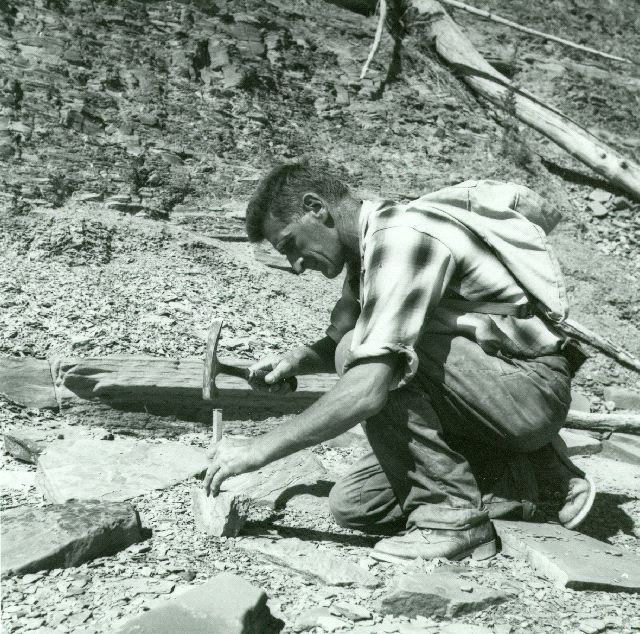Miguasha: A story written in stone
The Miguasha cliff is a witness to ancient history, offering an invaluable glimpse into the evolution of life and the world 380 million years ago.
 (128 kb) For the dozens of millions of years, the cliff’s exposed sedimentary rock layers, which originally formed at the bottom of an ancient estuary, experienced multiple episodes of erosion that have shaped the landscape.
(128 kb) For the dozens of millions of years, the cliff’s exposed sedimentary rock layers, which originally formed at the bottom of an ancient estuary, experienced multiple episodes of erosion that have shaped the landscape.
By the end of the last great ice age 12,000 years ago, the region began to look like it does today. It appears that humans first ventured onto the Gaspé Peninsula 8,000 years ago, evidence of which is preserved at the La Martre archeological site on the northern margin of the peninsula.

 (96 kb)For centuries, the Miguasha cliff witnessed the activities of aboriginal people, being strategically located in a region of salmon rivers frequented by the Micmac (Mi’kmaq). After the Europeans arrived in North America, the cliff was witness to the final naval battle between the French and the English in the Ristigouche River estuary, a battle that would seal the fate of New France.
(96 kb)For centuries, the Miguasha cliff witnessed the activities of aboriginal people, being strategically located in a region of salmon rivers frequented by the Micmac (Mi’kmaq). After the Europeans arrived in North America, the cliff was witness to the final naval battle between the French and the English in the Ristigouche River estuary, a battle that would seal the fate of New France.
In the aftermath of the English victory, the cliff at Miguasha saw the arrival of families who put down roots in the surrounding area. And one day, in the summer of 1842, the cliff was visited by physician and chemist Dr. Abraham Gesner, its first official discoverer. It was 37 years later that Dr. Ells, as leader of a team from the Geological Survey of Canada, followed in Gesner’s footsteps and rediscover the cliff’s fossil wealth.
From that moment forward, human history and scientific history became entwined. Year after year, with each blow of a hammer, the cliff patiently revealed its secrets to explorers and local collectors. As scientists unraveled its mysteries, they were able to add a new page to the history of life on Earth. Miguasha’s story, written in stone some 380 million years ago, continues to unfold, bit by bit, as it has done for more than 125 years. And it is a story that is far from finished!

 (128 kb) For the dozens of millions of years, the cliff’s exposed sedimentary rock layers, which originally formed at the bottom of an ancient estuary, experienced multiple episodes of erosion that have shaped the landscape.
(128 kb) For the dozens of millions of years, the cliff’s exposed sedimentary rock layers, which originally formed at the bottom of an ancient estuary, experienced multiple episodes of erosion that have shaped the landscape. By the end of the last great ice age 12,000 years ago, the region began to look like it does today. It appears that humans first ventured onto the Gaspé Peninsula 8,000 years ago, evidence of which is preserved at the La Martre archeological site on the northern margin of the peninsula.

 (96 kb)For centuries, the Miguasha cliff witnessed the activities of aboriginal people, being strategically located in a region of salmon rivers frequented by the Micmac (Mi’kmaq). After the Europeans arrived in North America, the cliff was witness to the final naval battle between the French and the English in the Ristigouche River estuary, a battle that would seal the fate of New France.
(96 kb)For centuries, the Miguasha cliff witnessed the activities of aboriginal people, being strategically located in a region of salmon rivers frequented by the Micmac (Mi’kmaq). After the Europeans arrived in North America, the cliff was witness to the final naval battle between the French and the English in the Ristigouche River estuary, a battle that would seal the fate of New France.In the aftermath of the English victory, the cliff at Miguasha saw the arrival of families who put down roots in the surrounding area. And one day, in the summer of 1842, the cliff was visited by physician and chemist Dr. Abraham Gesner, its first official discoverer. It was 37 years later that Dr. Ells, as leader of a team from the Geological Survey of Canada, followed in Gesner’s footsteps and rediscover the cliff’s fossil wealth.
From that moment forward, human history and scientific history became entwined. Year after year, with each blow of a hammer, the cliff patiently revealed its secrets to explorers and local collectors. As scientists unraveled its mysteries, they were able to add a new page to the history of life on Earth. Miguasha’s story, written in stone some 380 million years ago, continues to unfold, bit by bit, as it has done for more than 125 years. And it is a story that is far from finished!
Site map | Feedback | Links | Sources | Credits
Miguasha: A story written in stone
<< From water to land | The Gaspé Peninsula: A world of oceans and mountains >>




